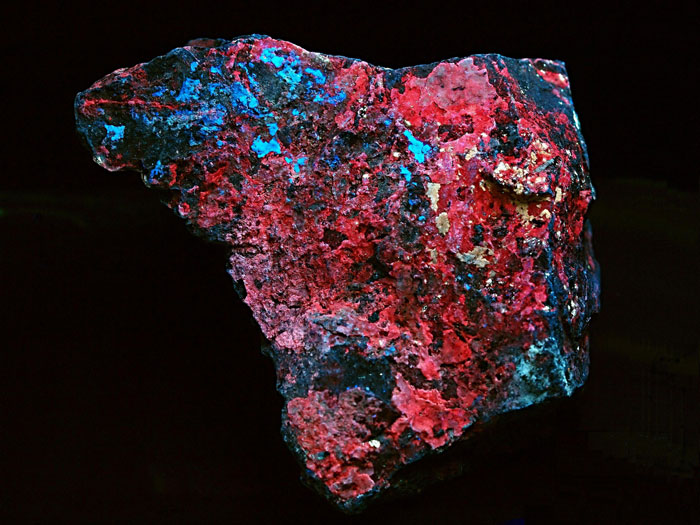Database of luminescent minerals
WICKENBURGITE
Chemical formula: Pb3CaAl2Si10O27 4H2O
Family: Silicates
Status: IMA-A
Crystal system : Rhomboedric
Display mineral: NON
Luminescence:
Longwave UV (365nm) colors: |
Yellowish White , | ||
Shortwave UV (254nm) colors: |
Red , Salmon pink , | ||
Intensity SW:Medium | |||
Daylight picture

WICKENBURGITE
From the Potter-Cramer Mine near Wickenburg, AZ USA
Photo and Copyright: Cran Cowan
Used with permission of the author;
Shortwave (254nm) picture

WICKENBURGITE (fluo red) & FLUORITE (fluo blue), UVSW
From the Potter-Cramer Mine near Wickenburg, AZ USA
Photo and Copyright: Cran Cowan
Used with permission of the author;
Pictures Galery:



 ...
...Do you have a photo of this mineral you would like to see in the gallery? Contact us!
Phosphorescence (in the common sense of the term) observable with the naked eye:
No data
Activator(s) and spectrum:
No dataNo spectrum yet
Best localities for fluorescence (*):
- Potter-Cramer mine, Wickenburg, Maricopa County, Arizona, USA;
- Rat Tail claim (Pack Rat claim), Wickenburg area, Belmont Mts, Maricopa Co., Arizona, USA;
- Anchor mine, Wickenburg, Maricopa County, Arizona, USA;
(*)The data are not exhaustive and are limited to a few remarkable localities for fluorescence
Bibliographic reference for luminescence:
- The Henkel Glossary of Fluorescent Minerals, Dr. Gerhard Henkel, Published by the FMS, 1989 ,
- Fluorescence: Gems and Minerals Under Ultraviolet Light, Manuel Robbins, 1994, Geoscience Press, ISBN 0-945005-13-X ,
- The World of Fluorescent Minerals, Stuart Schneider, Schiffer Publishing, 2006, ISBN 0-7643-2544-2 ,
Reference for luminescence on the Internet:
Mineralogical reference on the Internet:
 http://www.mindat.org/show.php?name=Wickenburgite
http://www.mindat.org/show.php?name=Wickenburgite
 http://webmineral.com/data/Wickenburgite.shtml
http://webmineral.com/data/Wickenburgite.shtml
Internet Search:
 Image search on 'Google Images'
Image search on 'Google Images'
 Search for documents in all languages on Google
Search for documents in all languages on Google
A request providing no result means only that no such reference exists in the database, but it does not mean that what you are looking for does not exist, just not to our knowledge. If you think you have found an error or omission, please let us know via the contact page being sure to cite the source of information.

